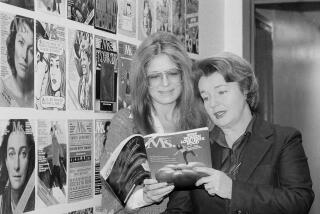Turning Out the Lights at Mirabella
Grace Mirabella, the founder of the women’s magazine that bears her mellifluous name, was planning to introduce the new editor in chief at a Fashion Week party scheduled for Saturday at the Bowery Bar in Manhattan.
But the party has been canceled as the editor, Dominique Browning, and all the other staffers count down the hours to what may be the extinction of the magazine.
Rupert Murdoch’s News America Publishing Inc., which announced last week that the May issue (Browning’s first) will be the company’s last, has set a deadline of today to find a buyer.
If one doesn’t appear, it’s lights out at the respected magazine for mature women after six years of publication with no black ink in sight. As one of the employees put it Monday, “The mood here is that we would love to have a white knight come save us.”
The only serious candidate at this 11th hour appears to be Hachette Filipacchi Magazines, which recently announced plans to buy Family Life and launch a political mag called George.
If critical appreciation were enough to sustain a magazine, then Mirabella would have a long life ahead of it. The April issue, fronted by a wind-swept Brooke Shields in a $995 silk charmeuse dress by Ralph Lauren, contains a profile of the actress and a fashion spread featuring the ubiquitous Kate Moss (yes, even in Mirabella). But the array of other features shows that the magazine separated itself from Vogue, Elle and Harper’s Bazaar by paying less attention to fashion (probably at its peril) and greater heed to arts and letters.
The pieces include a profile of the enduring singer Joni Mitchell (as the mag says, “So what if she doesn’t rack up the sales that her young acolytes do”), a whimsical essay by Allan Gurganus on the joys of home and a heady reflection by Lawrence Klepp on the convenience of blaming Satan.
Bottom line: Mirabella had shown nice circulation growth in recent years, rising 4% in 1994 to 637,000. This sum included a solid number of paid subscriptions--more than 500,000--that remains one of its most valuable assets. At the same time, the mag was losing between $5 million and $7 million a year, according to the industry newsletter Folio: First Day.
Murdoch, who also owns the New York Post, has reportedly been operating that publication at a big deficit, but the newspaper gives him an editorial platform in the life of the city. At Mirabella, the publisher’s position has been vacant since January, when Catherine Viscardi Johnston left for Mademoiselle, and the number of advertising pages and total ad revenue have dropped sharply this year.
“I hope someone is going to see how a good thing was mishandled--I don’t mean editorially--and can see that we have a really good thing going here,” said Mirabella, the former editor of Vogue. “I haven’t played much of a role in the past few years and I think maybe that was a mistake.”
“If Mirabella has been as unprofitable as rumor had it, then it’s probably a sound decision to close it in this era where it seems that you at least have to break even,” said Roberta Garfinkle, senior vice president and director of print media at the McCann-Erickson advertising agency. “On the other hand, it saddens me, especially when you look at what happened to the other magazines that reached upscale, intelligent women--New York Woman and Lear’s.”
They, too, are no more.
*
Buenos Dias, Oscar: Padres de Sesame Street is the newly launched Spanish-language edition of Sesame Street Parents magazine. Published in New York by the Children’s Television Workshop, which produces “Sesame Street” on public TV, the new quarterly publication offers health and nutrition information, as well as a supplement about the show’s furry gang. A total of 400,000 copies are being distributed free to the offices of obstetricians and family physicians who practice in predominantly Latino areas.
* Paul D. Colford’s column is published Fridays.






